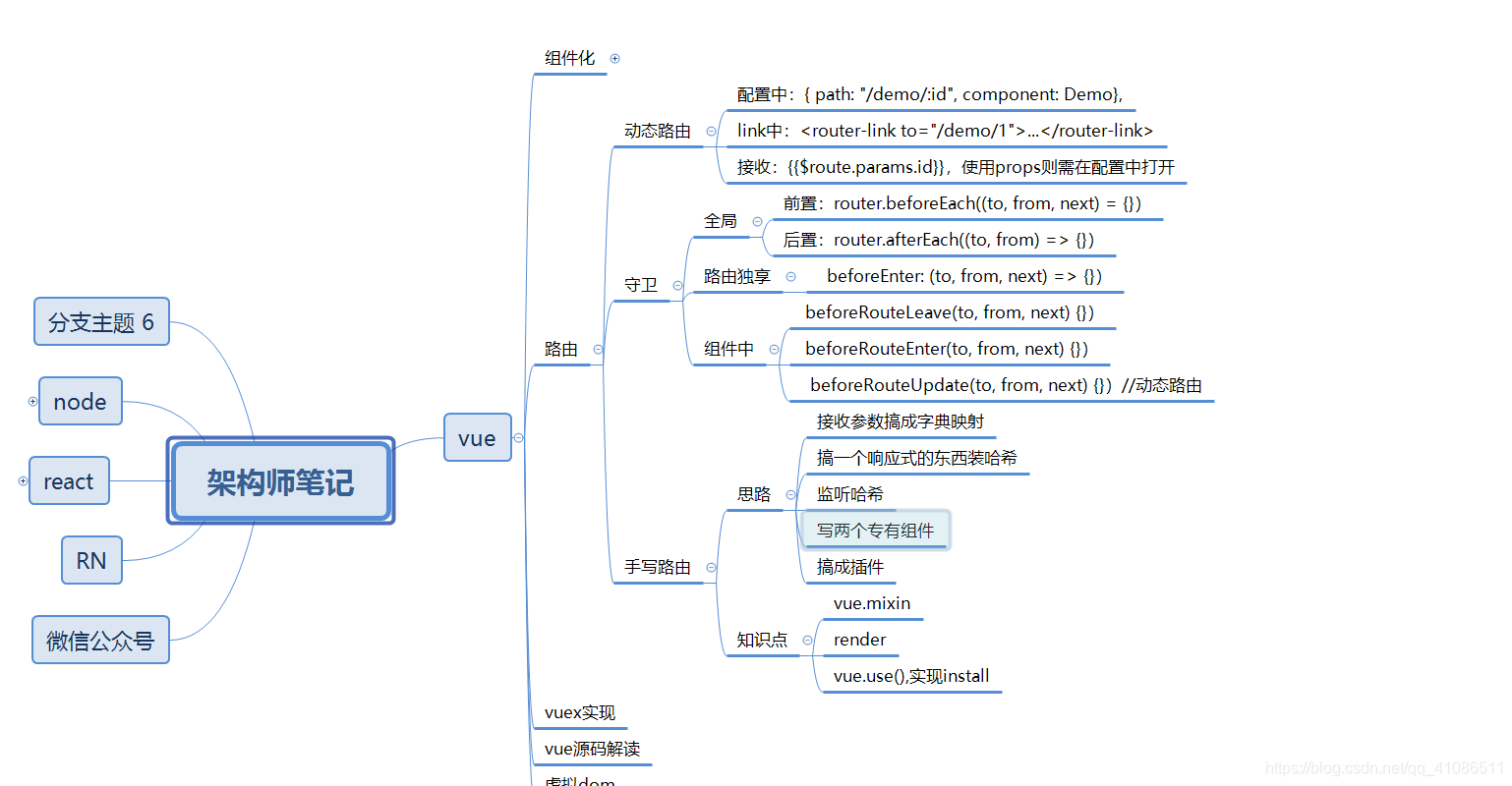知识导航:
- 路由重要知识点
- 手写一个路由
知识点(建议最后看,放到是为了方便复习)

1. 路由重要知识点
vue-router对于写过vue的人想必是很熟悉了,所以这里忽略它的一些基本用法了。
1.1 动态路由
所谓动态路由就是类似那种restful接口对接形式,即以/demo/:id,即可匹配到demo路由同时可在demo路由下的组件中拿到传过来的id值。
示例:
路由配置中:
{
path: "/",
component: Home,
children: [
{ path: "", name: "home", component: List },
{ path: "/demo/:id", component: Demo},
]
}
发出链接组件中的router-link
<router-link to="/demo/1">...</router-link>
接收组件
{{$route.params.id}}
或者
将路由routes配置中更改为{ path: "/demo/:id", component: Demo,props:true}
这时候接收组件便可以通过props来接收参数了,例如{ props: ['id'] }
1.2 路由守卫
1.2.1 全局守卫
就是一些钩子,通过运行这些钩子的执行时期来做一些我们想要的控制。即每次发生路由的跳转变化执行一下我们所设置的某些逻辑
1.2.1.1 前置钩子(即前置守卫)
//to:即要进入的路由
//from:即要离开的路由
//next:它是一个函数,即可控制是否能够进入下个路由
//它的参数形式(1)next(); //默认路由(2)next(false); //阻止路由跳转(3)next({path:'/'}); //阻止默认路由,跳转到指定路径
router.beforeEach((to, from, next) = {
if (to.path == "/login") {
next();
} else {
next("/login")
}
})
1.2.1.1 后置钩子(即后置守卫)
后置钩子用法和前置钩子基本一样,只不过它所接受的函数参数中没有了next
router.afterEach((to, from) => {
//逻辑代码
})
1.2.2 路由独享
使用和全局类似。
示例:
//登录模块
path: '/login',
component:Login,
beforeEnter: (to, from, next) => {
if (to.meta.needLogin && !$store.state.isLogin) {
}
1.2.3 组件内的守卫
直接放进组件中的路由钩子。
即:(说明放在代码中)
export default {
//出去时触发
beforeRouteLeave(to, from, next) {
next();
},
//进来时触发
beforeRouteEnter(to, from, next) {
next();
},
//它的场景是那种动态路由,如此组件匹配的是/demo/:id,即虽路由发生了变化但还是进到当前组件
beforeRouteUpdate(to, from, next) {
next();
},
data: {},
method: {}
};
2. 手写一个路由插件
思路:回想我们在使用路由的时候进行了哪些配置。(ps只是基础实现功能)
观察
路由配置js文件中:

入口main.js文件:

通过观察可以知道我们接下来要做什么了。
- 写一个路由类
- 构造函数需要接受传过来的参数
- 要有一个path和组件信息字典即需要把参数整成{path:组件名}
- 需要有个响应式的东西用于存放url中的哈希值
- 需要监听url中哈希值的变化
- 需要做两个组件,router-link和 router-view
- 需要把它做成插件
1.开始
current用于存放哈希值借用vue的响应式数据,map用于存放path和组件信息的映射
class MyRouter {
constructor(routes) {
this.$routes = routes;
this.map = {};
this.app = new Vue({
data: {
current: '/'
}
})
}
2.接下来先把它整成一个组件吧
首先我们要理解在路由配置js文件中Vue.use()。它的作用是安装插件,如果插件是一个对象则该对象必须提供install方法。如果插件是一个方法,那么这个方法便会被做为install方法。并且在调用install方法时,Vue会作为参数传进去。
即我们想要把上面写的东西搞成一个组件,就得实现一个install方法。
下面我们用了一下混入,即Vue.mixin({})。简单说一下它,它的作用是全局注册一个混入,即它会影响注册之后创建的每一个vue实例。既然可以影响每个vue实例,那我们可以搞一个vue的钩子。控制vue实例在它的生命周期中做些我们让它做的事情
MyRouter.install = function(_vue) {
Vue = _vue;
Vue.mixin({
beforeCreate() {
//判当前vue实例化是的初始选项是否有router,有就调用router的初始化方法
if (this.$options.router) {
this.$options.router.init();
}
}
})
}
3.实现init方法
init() {
// 初始化要做的事情:
// 1.进行哈希值的监听
this.addEvent();
// 2.做好字典映射
this.creatMap(this.$routes);
// 3.整好路由的两个专有组件
this.creatCom();
}
4.实现监听addEvent
addEvent() {
哈希值给到current,current是响应式的即哈希值一变,所有的用到current的地方便 跟着变化
window.addEventListener("hashchange", function() {
// 哈希值一改变对应的current便需要改变,注意这里的this指向为window
this.app.current = window.location.hash.slice(1) || "/";
}.bind(this));
window.addEventListener('load', function() {
this.app.current = window.location.hash.slice(1) || "/";
}.bind(this));
}
5.实现path与组件信息的映射creatMap(routes);
creatMap(routes) {
routes.routes.forEach(item => {
this.map[item.path] = item;
});
}
6.创键两个专有组件creatCom()
creatCom() {
Vue.component("router-link", {
props: {
to: String
},
//就是渲染一个a标签
render(h) {
return h("a", {
attrs: {
href: "#" + this.to
}
}, this.$slots.default)
},
});
Vue.component("router-view", {
//将组件渲染成真正的DOM视图
render: (h) => {
return h(this.map[this.app.current].component)
}
})
}
测试:引用我们写的路由

效果:


路由完整代码:
// 思路
// 1.接收一个map的配置信息
// 2.监听哈希值的变化
// 3.哈希值一旦法师变化,重新渲染页面
let Vue;
class MyRouter {
constructor(routes) {
this.$routes = routes;
this.map = {};
this.app = new Vue({
data: {
current: '/'
}
})
}
init() {
// 初始化要做的事情:
// 1.进行哈希值的监听
// 2.做好字典
// 3.整好路由的两个专有组件
this.addEvent();
this.creatMap(this.$routes);
this.creatCom();
}
addEvent() {
window.addEventListener("hashchange", function() {
// 哈希值一改变对应的current便需要改变,注意这里的this指向为window
this.app.current = window.location.hash.slice(1) || "/";
}.bind(this));
window.addEventListener('load', function() {
this.app.current = window.location.hash.slice(1) || "/";
}.bind(this));
}
creatMap(routes) {
routes.routes.forEach(item => {
this.map[item.path] = item;
});
}
creatCom() {
Vue.component("router-link", {
props: {
to: String
},
render(h) {
return h("a", {
attrs: {
href: "#" + this.to
}
}, this.$slots.default)
},
});
Vue.component("router-view", {
render: (h) => {
return h(this.map[this.app.current].component)
}
})
}
}
// 写成一个插件
// 即实现一个install方法
MyRouter.install = function(_vue) {
Vue = _vue;
Vue.mixin({
beforeCreate() {
if (this.$options.router) {
this.$options.router.init();
}
}
})
}
export default MyRouter